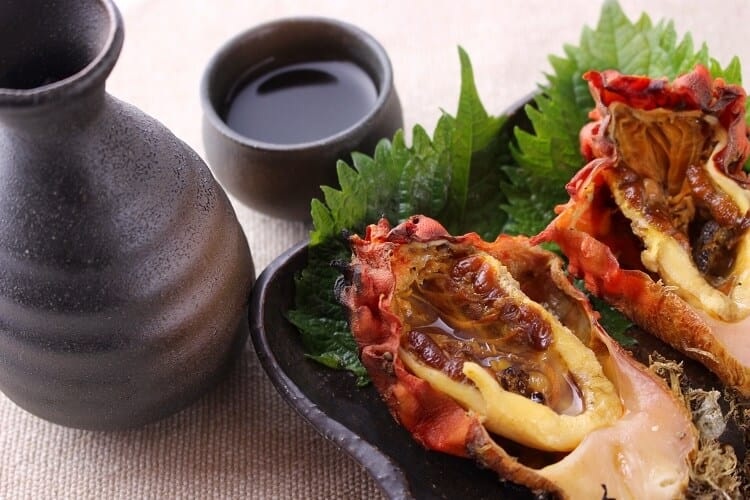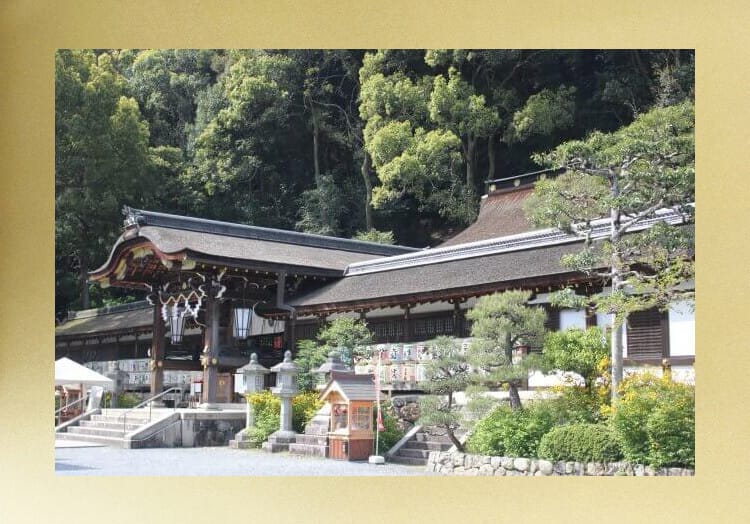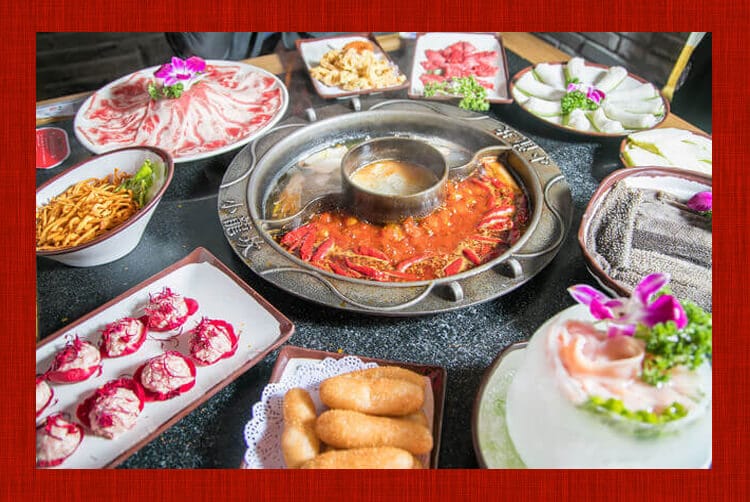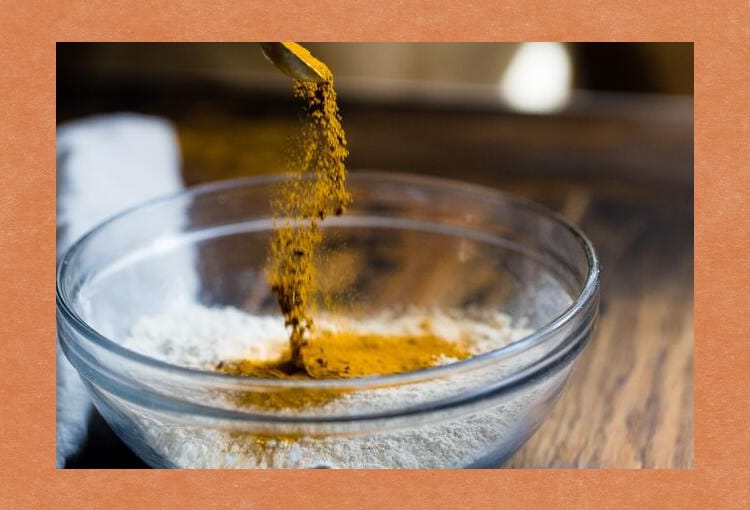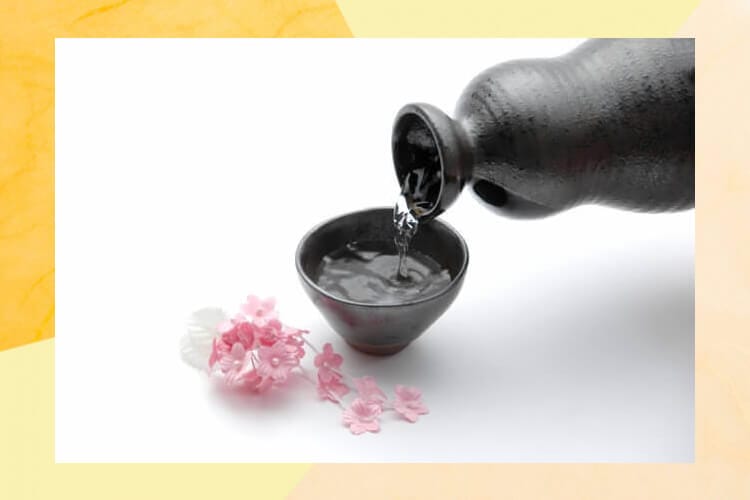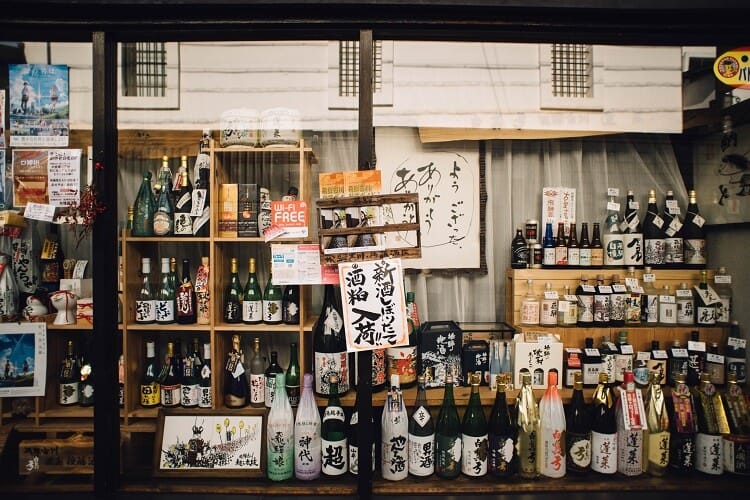
There are various types of sake such as Daiginjo, Ginjo, Junmai Sake and Nigori Sake. According to the overview of the sake manufacturing industry in 2019 (according to the survey in FY Heisei 29), the number of brewers nationwide is 1,415. The brands made are said to be more than 10,000.
Sake is made with a mix of brewer's wisdom, experience, and complex elements, each with a slightly different taste.
In order to make it easier for even beginners to understand sake, the types of sake are listed in categories and images.
Use this when you have trouble with sake words that have similar meanings, when you find a type of sake that you didn't know before, or when you are looking for your favorite sake.
The first difference between pure rice and brewed sake
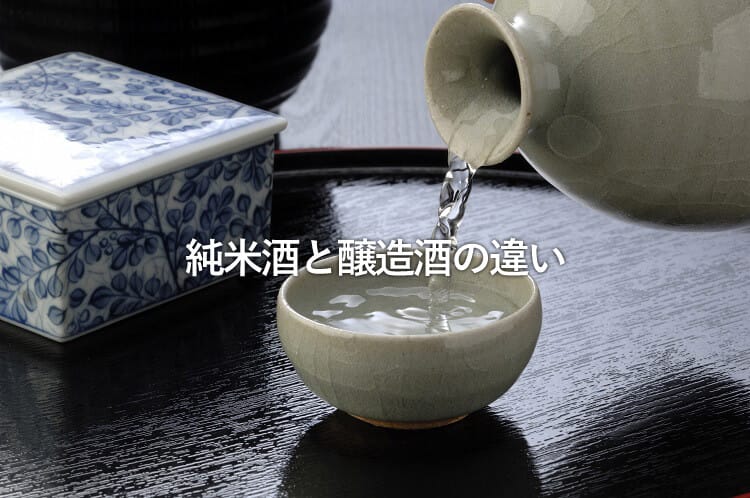
Why is the sake called “Pure Rice Sake” even though it must be made from rice? And why would you call “brewed sake” as if you were n’t using rice?
Now, if you receive such a question, you may laugh, “Do you know that?” I was the first person to drink sake, but I was really thinking about it.
| Junmai | Japanese sake made with rice, rice cake * and water only.
No brewed alcohol is used. |
| Brewed sake | Japanese sake made by adding brewed alcohol to rice, rice bran and water. |
* Salmon is steamed rice, cooled to 30 ℃, and sprinkled with koji molds. As the koji mold grows and grows, various ingredients are stored in koji, becoming a nutrient source for sake yeast and an umami ingredient that determines the quality of sake.
The difference between brewed sake and pure rice sake is whether or not brewed alcohol is added (also referred to as Alzo).
If you use the word “addition” here, brewing alcohol sounds like a bad additive to your body, but brewing alcohol is safe enough to be considered almost the same as shochu. The raw material is derived from food, and when used for sake brewing, it is reduced to a frequency of 30%.
The reason for adding brewed alcohol is to make the taste of Japanese sake refreshing and refreshing so that ginjo aroma (fruity fragrances such as Daiginjo and Ginjo sake) stand out.
[Specific name liquor] classified into 8 types by rice polishing rate and taste
The specific name liquor is a sake that meets the “Sake Sake Process Quality Labeling Standard”.
- Daiginjo, Ginjo, Special Honjozo, Honjozo
- Junmai Daiginjo, Junmai Ginjo, Special Junmai, Junmai
It can be divided into I tried to classify them by the percentage of polished rice and the presence or absence of alcohol.
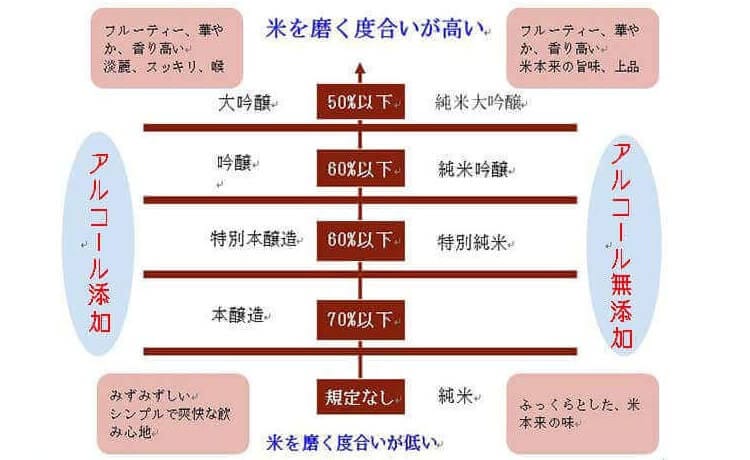
(In-house creation)
Sake, which has a higher degree of polishing rice, has less protein and oils and is made only of starch. There is no miscellaneous taste and you can enjoy a refreshing taste and fragrant Ginjo incense.
Add brewed alcohol to create a refreshing taste and refresh the taste. Compared to that, pure rice sake is a soft and comfortable drink with a lively taste of rice.
To give yourself a specific name sake,
- Use sake-brewed rice (Yamada Nishiki, etc.)
- Use graded rice even if it is suitable for sake brewing
- Add brewed alcohol to 10% of rice weight
Is also required.
If you use non-grade rice or add more than 10% alcohol, it is defined as “normal liquor”.
Classified as 3 by liquor mother
Sake mother who becomes the basis of alcoholic fermentation when making sake. This is a culture of yeast necessary for fermentation of moromi.
There are 3 types of liquor mothers. They are Sakujo Mochi, Ginger, and Yamaha Moto.
Currently, the main sake sake used in sake is fast brewing sake, but ginger and mountain ruins are also used, which are called “ginger filling” and “mountain scrapping” respectively. There is.
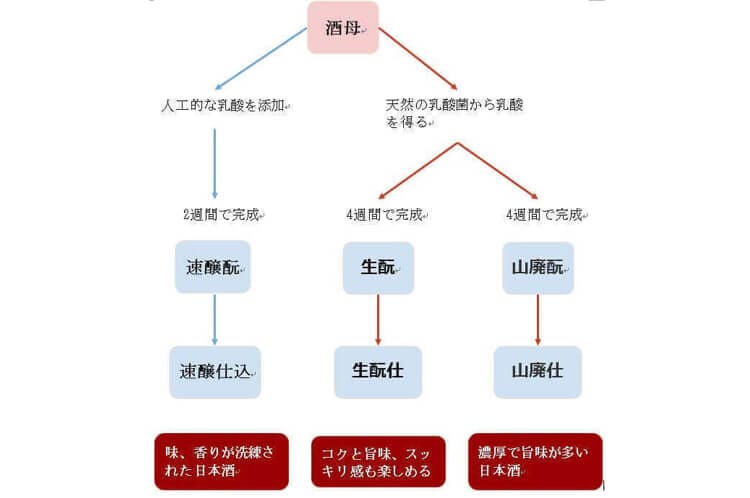
Quick brewing
This sake uses quick brewed sake made by artificially adding lactic acid to prevent the propagation of other bacteria other than yeast.
Why add lactic acid? This is because various bacteria dislike acidity. It takes 2 weeks to complete a fast-brewed sake-free mother. The sake brewing process is speedy and the taste is simple, so today's fast brewing is mainstream.
The characteristics of Japanese sake made by the mother
- Refreshing taste
- Fragrant
- Because there is no habit, it is ideal for brewing sake
And so on.
Ginger preparation
Unlike quick brewer's yeast, which is made by adding artificial lactic acid, ginger-making is characterized by the use of natural lactic acid, which is made by waiting for lactic acid bacteria in the air to make lactic acid.
In order to incorporate the lactic acid bacteria in the air into the steamed rice mix of steamed rice, water, and rice cake, the mixture in the rice cake is made muddy while being kneaded or crushed by hand using rice cake. is needed.
This work was called “mountain wholesale” and it was very hard work because it had to be done at midnight in the cold season to avoid the propagation of germs.
But the finished ginger-made sake tastes exceptional! Despite its richness and umami, it has a refreshing mouth.
By the way, the current method of unloading is not a manual work but agitated with a propeller.
Mountain scrapping
The wholesale work introduced in the section on ginger preparation above. The abandonment process is a cut off of this hard work. The term mountain abolished comes from “having abolished mountain wholesale work”.
What is put in place of the mountain wholesale work is “water tank”. If you soak the salmon in water, the enzyme will ooze out. Sprinkle this enzyme-containing liquid on the steamed rice.
The sake that is abandoned in the mountains has a rich, umami taste and a thick taste.
Classified as 4 by number of fires
An important way to make sake. This is a method to prevent the deterioration of quality by extending the storage period of sake.
The method of heating is to put raw sake in a tank and warm it indirectly from 60 ℃ to 65 ℃, and after 30 minutes, cool rapidly to 10 ℃.
Usually, the burning is done 2 times, but there are also sakes that are not fired and those that have been reduced in the number of times, and the way they are called varies.
| (general) Sake |
Fresh storage |
Raw stuffing |
Fresh sake |
| ・ Fired 2 times before bottling.
・ After the bottling, the 2 fire may occur. |
・ Fire only 1 times just before bottling or after bottling.
・ It is distributed as “live” in the market. |
・ Fire only 1 times before storage.
・ "Hiyaoroshimo" is included in this category. |
・ Real life without any burning. |
| Fresh storage liquor, fresh stuffing, and fresh sake all bear the word “raw”, but the only sake that wasn't really fired was fresh sake! |
Classify into 4 types by squeezing
There is a process called “Joso” when making sake. It is also called “squeezing” in the process of filtering the koji to remove sake lees. There are several ways to squeeze, and the taste will change depending on how you squeeze.
Here are some typical 4 squeezing methods.
Among these drawing methods, the “Yabuta” type is the most commonly used mechanical drawing. Centrifugation is the latest squeezing method. Others are traditional drawing methods.
| Yabuta type (automatic press filter) | A method of squeezing sake under pressure by a machine.
● Since it takes a short time to finish squeezing, there is little oxidation. ● Because it can be squeezed firmly, it is economical without waste. ● Ideal for regular sake and book brewing. ● High pressure makes it unsuitable for delicate Daiginjo. |
| Tank squeezed | Traditional way of squeezing from ancient Japan. A method to make a long and narrow box similar to a ship, put a sake bag with straw in it, and squeeze it under pressure from above.
● How to squeeze close to the natural weight. ● The pressure is not as strong as the Yabuta type, so it is suitable for Daiginjo. |
| Squeeze shizuku | Also called bag hanging. A Japanese sake that is hung in a sake bag and collected from drops of sake that has fallen due to gravity alone.
● Daiginjo is also used to make even higher quality sake. ● There is almost no miscellaneous taste. ● A refreshing taste. ● It is expensive because the amount that can be taken is small. |
| Centrifuge | A method in which only the supernatant is taken by rotating the bowl in the container at high speed.
● When mash is packed in a sake bag, sake may have the smell and miscellaneous taste of sake, but this method can prevent the smell and miscellaneous taste. ● Enjoy the original taste and aroma of sake. ● You can also make nigori liquor by changing the number of revolutions. |
Famous for the sake squeezed by centrifugation is the “Sakai Matsuri”. If it is squeezed by centrifugation, only 1 ℓ can be squeezed in 400 times, so it is an inefficient method, but the aroma and taste of sake are alive.
In addition, Kitayuki Shuzo's Kitayuki and Katsuyama Shuzo's Junmai Daiginjo Tsumugi are also squeezed by centrifugation.
Although it is a little expensive compared to normal squeezing, it is worth trying ♪
Classification into 3 types during squeezing
Sake is filtered by squeezing the koji, but squeezing is not the only story, so sake is deep!
First, let's take a look at the liquor that appears at the beginning of the squeezing, the liquor that is squeezed in the middle, and the liquor that is squeezed in the final stage.
| Storm
|
The first bottle of liquor that flows out.
● When squeezing with an "automatic squeezing filter" ... Sake at the beginning of squeezing. ● When squeezing with "tank squeezing" ... Sake that exudes when you just stack sake bags before applying pressure. ● When squeezing with "Shizukushibori" ... Sake that first drips when hung in a liquor bag. feature is, ● It becomes white and turbid because it contains mash components that have not been filtered. ● Fresh and rich flavor. ● Strong taste and aroma. |
| Inside pumping (room arrangement) | A bottle of sake that has been squeezed next to the brew.
● It is clear without cloudiness because it is after the turbid liquor is exhausted. ● The quality is stable because it does not contain ingredients that make miscellaneous flavors. ● The best quality part. |
| Blame | A bottle of sake squeezed from the inside.
● High alcohol content ● There is a lot of miscellaneous taste, but there is flavor |
Since recent sake is squeezed at once with a machine, “arabashiri”, “pumping inside”, and “blaming” are mixed, and there are many things that are not distinguished from each other.
Therefore, it can be said that brewer's sake, which is classified as “Arabashiri”, “Nakafumi”, and “Blaming”, is made with more time and effort than ordinary sake.
Nigori sake is classified into 3 types
I explained that arabashiri was cloudy because it was cloudy, but in a word it wasn't one type. From here, we will introduce the types and characteristics of nigari sake, which is also popular with women.
Sake
“Ori” refers to the cloudy part of sake.
When squeezing the koji, it is put in a bag, but even if it is squeezed as it is, the white part of the koji will not be filtered and will be put into sake. Normally, leaving it as it is, the white part settles and the supernatant remains. It is normal to use the supernatant, but the sake is a white portion of the bottle.
Since the cage contains strawberry and yeast, the taste of the sake is richer than ordinary sake and has a sweet taste. The true identity of the cage is sake lees. In other words, sake is like an energy drink full of vitamins.
Sagori
It's a sake that is slightly cloudy. There are only a few nigari portions, so in addition to the delicate and refreshing taste of sake, it is a nigari sake that you can enjoy the flavor of rice.
Active
Nigari sake, also called “Japanese champagne”. Because it is not fired, the fermentation of the enzyme in the cocoon continues.
The activity is often used for celebrations and parties. Be careful when opening! If you don't open it slowly, the carbon dioxide gas will come out vigorously, and the liquor will be blown out, which may be a waste.
A light nigari liquor is recommended, but if you like a heavy liquor that is nutritious and good for beauty, why not try Hida no Dobu?
https://www.instagram.com/p/BtvguwtAglb/?utm_source=ig_web_copy_link
It is a genuine sake, not a doboku, but it is really “dro”. It is a niger sake that is suitable for those who prefer to eat rather than drink.
Summary: You can use a database to search for sake!

I explained sake by classifying it from various angles. However, if you want to know specific brands such as "I feel like I want to drink sweet nigari sake with hot water tonight!" .
The recommendation is “Sakenowa”. You can find your favorite 1 books you want to drink now. You can also see the characteristics of sake by prefecture.
Even more convenient is the ability to record the sake you drank. It comes in handy when “I want to record the sake that I drink right now so I don't forget it.” If you take a picture with a smartphone, add a simple comment, and save it, the number of "Do n’t drink, what?"
Download the Sakenowa appplease use this form..
If you only remember the name of the sake brewer, why not use the “Sake Brewery Information” database of the SAKETIME web media that sends Japanese sake information? You can check not only Japan but also overseas breweries and recommended brands.
This is not an app but thisPages.
Reference:
National Tax AgencyNumber of companies, production volume, export / import volume (by sales volume scale and company type)'

